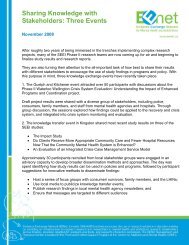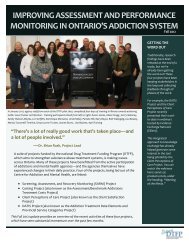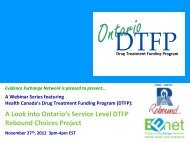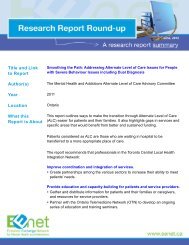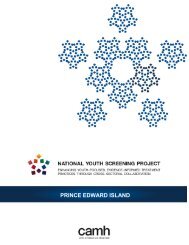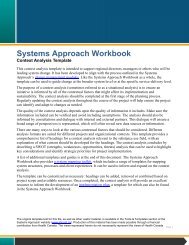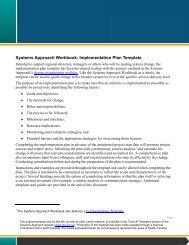Implementation of Early Psychosis Intervention Program ... - EENet
Implementation of Early Psychosis Intervention Program ... - EENet
Implementation of Early Psychosis Intervention Program ... - EENet
Create successful ePaper yourself
Turn your PDF publications into a flip-book with our unique Google optimized e-Paper software.
46o More funding and more consistency in funding policy, including availability and use <strong>of</strong>salary and sessional fees. One specific suggestion was to adjust the provincial physician(OHIP) fee schedule to include incentives for serving EPI clients.o Regional or network program role – for example, a regional program could have a dedicatedpsychiatrist/mobile medical team that travels to the communities and/or is available via OTNfor regular follow-up and accessible by phone.o Increasing system capacity – explore different strategies to develop EPI interest/expertiseamong psychiatrists – to create a larger pool <strong>of</strong> EPI aware psychiatrists to draw from.o Family physician pool – explore strategies to develop EPI interest/expertise among familyphysicians including awareness <strong>of</strong> the need for medical monitoring.4. Comprehensive assessmentStandard 2 sets out the minimum requirements for a comprehensive assessment for clients whoare referred to EPI programs and appear to meet the eligibility criteria. The requirements includeactive engagement with client, assessing risk and presenting symptoms, assessing psychiatric,physical health and psycho-social dimensions, in addition to consideration <strong>of</strong> vocational,education and occupational domains in the individual’s life.Summary <strong>of</strong> Results (see Table 11):o <strong>Program</strong>s reported that their comprehensive assessment ‘usually’ included a psychiatricexam, assessment <strong>of</strong> presenting symptoms, risk assessment, substance use assessment,developmental history, psychosocial assessment, cultural assessment, family information,review <strong>of</strong> client understanding.o Less frequently the assessment addressed education (62%) and vocational issues (52%).o <strong>Program</strong>s reported low frequency <strong>of</strong> providing a physical exam (23%) and neurologicalassessment (15%), especially for community agency sponsored and small programs.o Psychiatric assessments were provided less <strong>of</strong>ten by small than large programs;developmental assessments were provided less <strong>of</strong>ten by community agency than hospitalsponsored programs.o <strong>Program</strong>s may benefit from written guidelines and supporting tools such as the OntarioCommon Assessment <strong>of</strong> Need 47 to ensure routine focus on all elements, but may also needassistance to access necessary expertise.o Some elements were not seen as immediate priority by staff and were assessed after initialassessment – physical, vocational.47 Ontario Common Assessment <strong>of</strong> Need is a standardized client assessment being implemented in communitymental health programs in Ontario.



